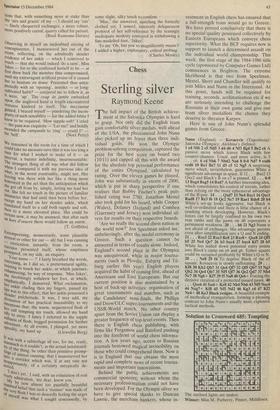Chess
Sterling silver
Raymond Keene
rr he full impact of the British achieve- '. ment at the Salonika Olympics is hard to grasp. Not only did the English team gain comfortable silver medals, well ahead of the USA, the phenomenal John Nunn also picked up no fewer than three indi- vidual golds. He won the Olympic problem-solving competition, captured the prize for the best score on board two (10/11) and capped all this with the award for the absolute top personal performance of the entire Olympiad, calculated by rating. Over the eleven games he played, John was substantially in excess of 2800, which is put in sharp perspective if one realises that Bobby Fischer's peak pub- lished rating was 2780. Jonathan Mestel also took gold for his board, while Cooper (Wales), Delaney (Ireland) and Comben (Guernsey and Jersey) won individual sil- vers for results on their respective boards.
'Are we really the second chess nation in the world now?' Jon Speelman asked me, unbelievingly, after the medal ceremony in Greece. Such a question cannot be answered in terms of results alone. Indeed, England's second place in the Olympics was unequivocal, while in major tourna- ments (such as Plovdiv, Esbjerg and Til- burg earlier this year) English players acquired the habit of coming first, ahead of Americans and East Europeans. But our current position is also maintained by a host of back-up activities: organisation of great tournaments and matches, such as the Candidates' semi-finals, the Phillips and Drew/GLC super-tournaments and the USSR-World match. No other country apart from the Soviet Union can display a greater frequency of top-level events. Then there is English chess publishing, with firms like Pergamon and Batsford pushing into the forefront of world chess informa- tion. A few years ago, access to Russian journals bestowed magical invincibility on those who could comprehend them. Now it is in England that one obtains the most rapid and complete news of recent tourna- ments and important innovations.
Behind the public achievements are commercial sponsors, without whom the necessary professionalism could not have been developed. For the Olympic silver we have to give special thanks to Duncan Lawrie, the merchant bankers, whose in-
vestment in English chess has ensured that a full-strength team would go to Greece. We have proved conclusively that there is no special 'quality possessed collectively by Eastern Europeans which conveys chess superiority. What the BCF requires now is support to launch a determined assault on the individual world championship. This week, the first stage of the 1984-1986 title cycle (sponsored by Computer Games Ltd) commences in Brighton. The extreme likelihood is that two from Speelman, Mestel, Short and Chandler will qualify to join Miles and Nunn in the Interzonal. At this point, funds will be required for training, seconds, acclimatisation etc if we are seriously intending to challenge the Russians at their own game and give our team silver medallists the chance they deserve to threaten Karpov.
Here is one of John Nunn's splendid games from Greece.
Nunn (England) — Kovacevic (Yugoslavia): Salonika Olympics; Alekhine's Defence. 1 e4 Nf6 2 e5 Nd5 3 d4 d6 4 Nf3 Bg4 5 Be2 c6 A passive move which leaves Black with few counter-chances. Usual, and more active, is 5 . . . e6. 6 c4 Nb6 7 Nbd2 Na6 8 0-0 Nd7 9 exd6 exd6 10 Rel Be7 11 d5 c5 12 Ng5 A surprising move which, nevertheless, guarantees White a significant advantage in space. If 12. . . Bxe2 13 Qxe2 and Black's B on e7 is pinned. 12. . . 0-0 13 Bxg4 Bxg5 14 Bxd7 A further interesting idea, which consolidates his control of terrain, rather than relying on the more ephemeral advantage of the B-pair. 14 . . . Qxd7 15 Ne4 Bxcl 16 Qxcl Rad8 17 Re3 f6 18 Qc2 Nc7 19 Rael Rde8 20 b4 White's set-up looks aggressive, but Black is well co-ordinated and there is little chance of a crushing attack developing. However, Black's forces can be largely confined to his own two rear ranks and the pawn on d6 represents a permanent weakness. 20. . . h6 21 Ng3 Nunn is not afraid of exchanges. His advantage persists even after simplification into a Q and N ending. 21. . . Rxe3 22 Rxe3 Re8 23 Rxe8+ Qxe8 24 Qf5 b5 25 Ne4 Qe7 26 b3 bxc4 27 bxc4 K17 28 h5 White has nailed down potential entry points into Black's camp on e6 and g6. Either square could be occupied profitably by White's 0 or N. 28 . . . Ne8 29 f4 To deprive Black of the e5 square. Kovacevic is slowly suffocating. 29. . . 1(18 30 Kh2 Qb7 31 Qe6 Qfl 32 Qf5 Qb7 33 Ng3 Qb2 34 Qe4 Qb7 35 Nf5 Qf7 36 Qe2 Qd7 37 NM Nc7 38 Ng6+ ICf7 39 f5 Na8 40 Qe6+ Forcing the decisive creation of a protected passed pawn. 40 . . . Qxe6 41 fxe6+ Ke8 42 Nh4 Nb6 43 Nf5 Nxc4 44 Nxg7+ Kfli 45 Nf5 Nd2 46 Kg3 c4 47 Kf2 Ne4+ 48 Ke3 Black resigns. A beautiful example of methodical strangulation, forming a pleasing contrast to John Nunn's usually more explosive tactical methods.


















































 Previous page
Previous page